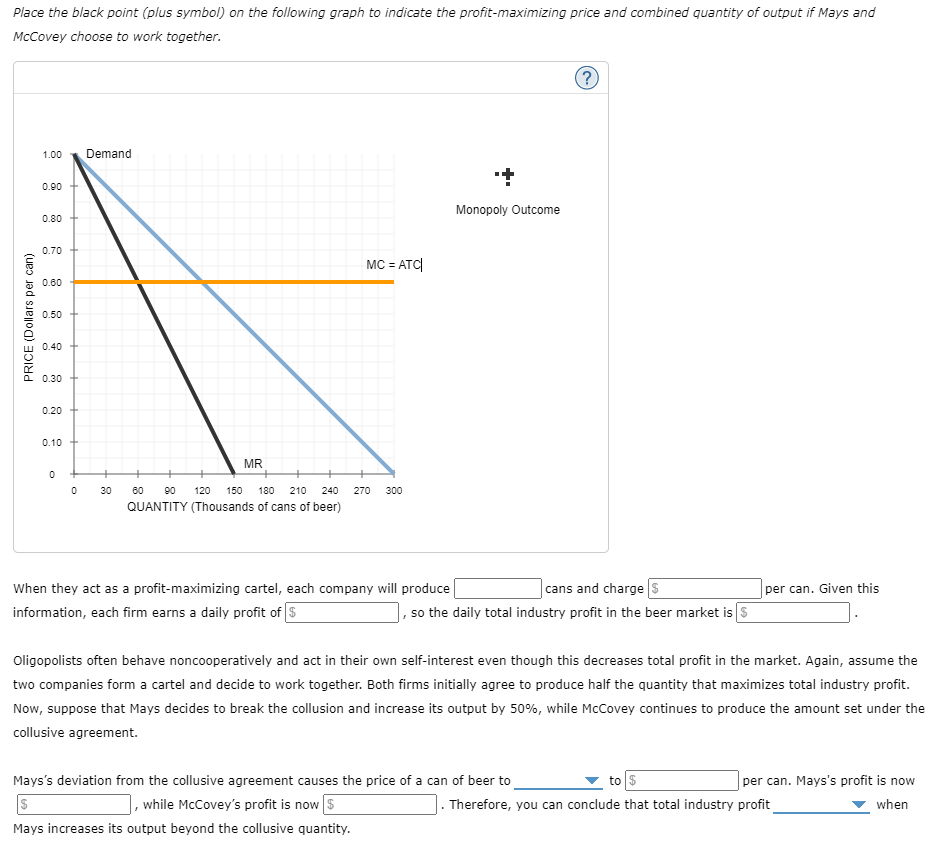Place the black point (plus symbol) on the following graph to indicate the profit-maximizing price and combined quantity of output if Mays and McCovey choose to work together. PRICE (Dollars per can) 1.00 Demand 0.90 0.80 0.70 0.60 0.50 0.40 0.30 0.20 0.10+ MC = ATC MR 0 + 0 30 60 90 120 150 180 210 240 270 300 QUANTITY (Thousands of cans of beer) Monopoly Outcome (?) When they act as a profit-maximizing cartel, each company will produce information, each firm earns a daily profit of $ cans and charge $ , so the daily total industry profit in the beer market is $ per can. Given this Oligopolists often behave noncooperatively and act in their own self-interest even though this decreases total profit in the market. Again, assume the two companies form a cartel and decide to work together. Both firms initially agree to produce half the quantity that maximizes total industry profit. Now, suppose that Mays decides to break the collusion and increase its output by 50%, while McCovey continues to produce the amount set under the collusive agreement. Mays's deviation from the collusive agreement causes the price of a can of beer to , while McCovey's profit is now $ Mays increases its output beyond the collusive quantity. to per can. Mays's profit is now Therefore, you can conclude that total industry profit when
Place the black point (plus symbol) on the following graph to indicate the profit-maximizing price and combined quantity of output if Mays and McCovey choose to work together. PRICE (Dollars per can) 1.00 Demand 0.90 0.80 0.70 0.60 0.50 0.40 0.30 0.20 0.10+ MC = ATC MR 0 + 0 30 60 90 120 150 180 210 240 270 300 QUANTITY (Thousands of cans of beer) Monopoly Outcome (?) When they act as a profit-maximizing cartel, each company will produce information, each firm earns a daily profit of $ cans and charge $ , so the daily total industry profit in the beer market is $ per can. Given this Oligopolists often behave noncooperatively and act in their own self-interest even though this decreases total profit in the market. Again, assume the two companies form a cartel and decide to work together. Both firms initially agree to produce half the quantity that maximizes total industry profit. Now, suppose that Mays decides to break the collusion and increase its output by 50%, while McCovey continues to produce the amount set under the collusive agreement. Mays's deviation from the collusive agreement causes the price of a can of beer to , while McCovey's profit is now $ Mays increases its output beyond the collusive quantity. to per can. Mays's profit is now Therefore, you can conclude that total industry profit when
Managerial Economics: Applications, Strategies and Tactics (MindTap Course List)
14th Edition
ISBN:9781305506381
Author:James R. McGuigan, R. Charles Moyer, Frederick H.deB. Harris
Publisher:James R. McGuigan, R. Charles Moyer, Frederick H.deB. Harris
Chapter11: Price And Output Determination: Monopoly And Dominant Firms
Section: Chapter Questions
Problem 2E: Ajax Cleaning Products is a medium-sized firm operating in an industry dominated by one large...
Related questions
Question
Pro hero pro expert Hand written solution is not allowed.

Transcribed Image Text:Place the black point (plus symbol) on the following graph to indicate the profit-maximizing price and combined quantity of output if Mays and
McCovey choose to work together.
PRICE (Dollars per can)
1.00 Demand
0.90
0.80
0.70
0.60
0.50
0.40
0.30
0.20
0.10
MC = ATC|
MR
0
0
30
60
90 120 150 180 210 240
270 300
QUANTITY (Thousands of cans of beer)
When they act as a profit-maximizing cartel, each company will produce
information, each firm earns a daily profit of $
+
Monopoly Outcome
(?)
cans and charge $
, so the daily total industry profit in the beer market is $
per can. Given this
Oligopolists often behave noncooperatively and act in their own self-interest even though this decreases total profit in the market. Again, assume the
two companies form a cartel and decide to work together. Both firms initially agree to produce half the quantity that maximizes total industry profit.
Now, suppose that Mays decides to break the collusion and increase its output by 50%, while McCovey continues to produce the amount set under the
collusive agreement.
Mays's deviation from the collusive agreement causes the price of a can of beer to
$
,while McCovey's profit is now $
Mays increases its output beyond the collusive quantity.
to $
Therefore, you can conclude that total industry profit
per can. Mays's profit is now
when
Expert Solution
This question has been solved!
Explore an expertly crafted, step-by-step solution for a thorough understanding of key concepts.
Step by step
Solved in 4 steps with 13 images

Knowledge Booster
Learn more about
Need a deep-dive on the concept behind this application? Look no further. Learn more about this topic, economics and related others by exploring similar questions and additional content below.Recommended textbooks for you

Managerial Economics: Applications, Strategies an…
Economics
ISBN:
9781305506381
Author:
James R. McGuigan, R. Charles Moyer, Frederick H.deB. Harris
Publisher:
Cengage Learning

Managerial Economics: A Problem Solving Approach
Economics
ISBN:
9781337106665
Author:
Luke M. Froeb, Brian T. McCann, Michael R. Ward, Mike Shor
Publisher:
Cengage Learning

Economics: Private and Public Choice (MindTap Cou…
Economics
ISBN:
9781305506725
Author:
James D. Gwartney, Richard L. Stroup, Russell S. Sobel, David A. Macpherson
Publisher:
Cengage Learning

Managerial Economics: Applications, Strategies an…
Economics
ISBN:
9781305506381
Author:
James R. McGuigan, R. Charles Moyer, Frederick H.deB. Harris
Publisher:
Cengage Learning

Managerial Economics: A Problem Solving Approach
Economics
ISBN:
9781337106665
Author:
Luke M. Froeb, Brian T. McCann, Michael R. Ward, Mike Shor
Publisher:
Cengage Learning

Economics: Private and Public Choice (MindTap Cou…
Economics
ISBN:
9781305506725
Author:
James D. Gwartney, Richard L. Stroup, Russell S. Sobel, David A. Macpherson
Publisher:
Cengage Learning

Microeconomics: Private and Public Choice (MindTa…
Economics
ISBN:
9781305506893
Author:
James D. Gwartney, Richard L. Stroup, Russell S. Sobel, David A. Macpherson
Publisher:
Cengage Learning

